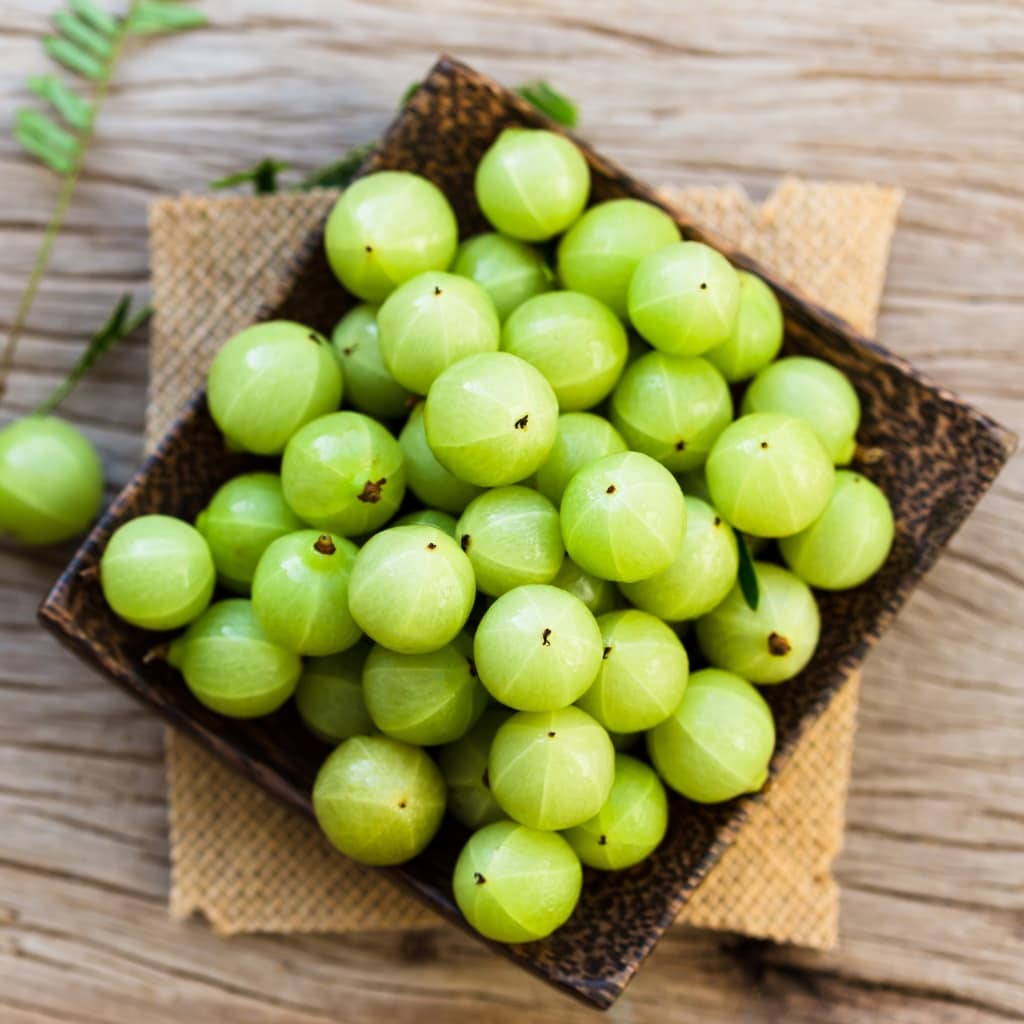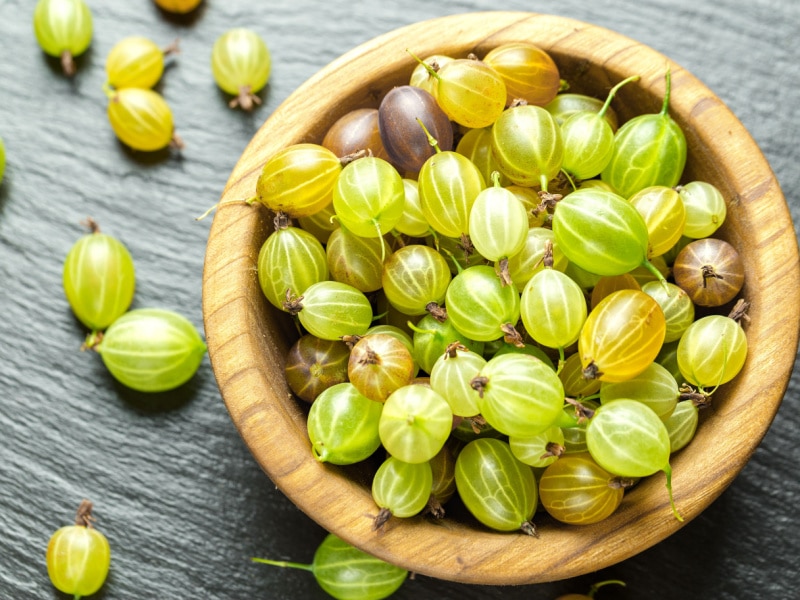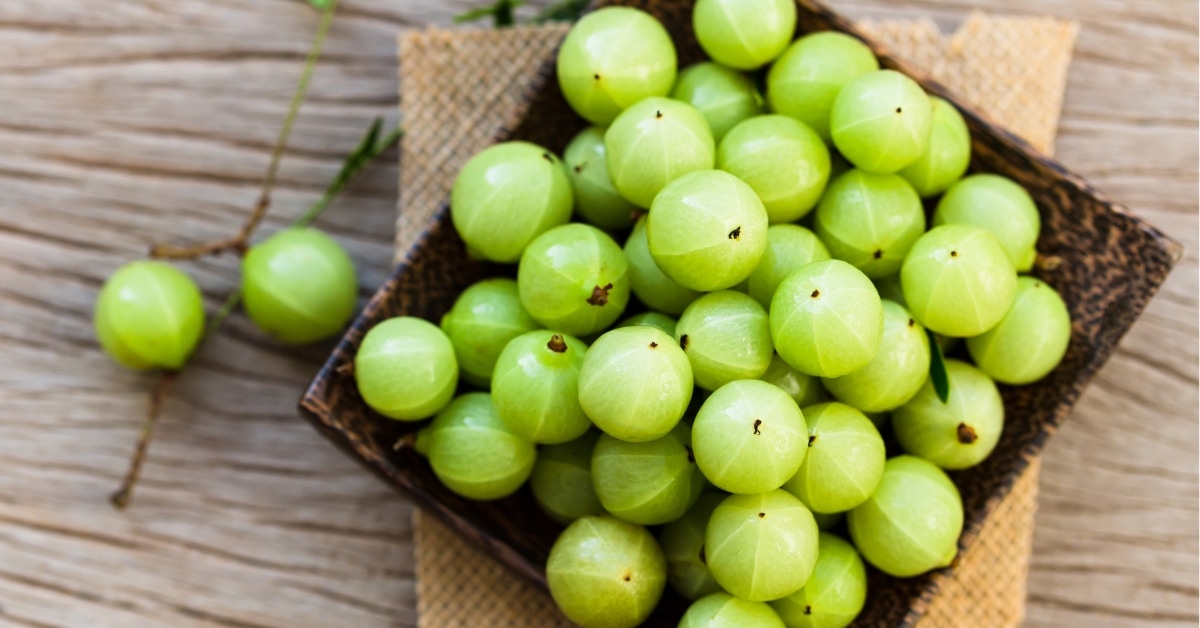You might be wondering, what are gooseberries, exactly?
In the world of strawberries, raspberries, and blueberries, gooseberries have been forgotten, especially if you’re from the United States.

However, even if you’ve never tasted a gooseberry, you might have heard of them.
If you’ve ever visited Duluth, Minnesota, there’s a chance you visited Gooseberry Falls.
And if you’ve ever watched a British period drama, you’ve likely heard of gooseberry pie. Bridgerton, anyone?
But even in Europe, where they’re more popular, gooseberries are often overlooked.
So, let me tell you all about these tart, tasty little berries.
What are Gooseberries?
Gooseberries are cute, little berries that come from the gooseberry bush.
They are edible (clearly, or I wouldn’t be writing about them).
In fact, they come from the same plant family as currants.
Gooseberries can be a range of colors from yellowish-green to pink to red to purple.
They’re small and round, with a diameter between 1/2 inch to 1-inch long.
And sometimes, they’re fuzzy. They’re also often striped. I think gooseberries look like a cross between cucamelons and grapes.
Like most fruits, they are less ripe when they are green. And then they ripen to their darker, red color.
They’ a’re edible when they’re green, though they’re not as sweet.
Also, gooseberries boast a myriad of health benefits.
They’re rich in fiber and antioxidants like vitamins E, A, and C and manganese. Oh, and they’re really low-calorie!
They can help the body fight aging, cancer, and heart disease. So, basically, they’re super-powered superfoods!
Now, you’re probably wondering why such fantastic fruits are so uncommon in the States.
Well, it’s because they were federally banned in the early 1900s.
Unfortunately, gooseberries can host a fungal disease that affects pine trees, and it killed a bunch.
While the ban was lifted in 1966, growing gooseberries is still restricted in some areas.

European vs. American Gooseberries- What’s the Difference?
Honestly, there’s not much difference between European and American gooseberries, and both have their pros and cons.
European gooseberries are more flavorful than their American counterparts.
They’re a little larger in size, so they carry more juice.
They’re also more susceptible to changing weather conditions and disease.
This is ironic, given that they’re native to the cooler parts of northeastern Europe.
Regardless, they can be difficult to grow.
American gooseberries are much less fussy. They’re more resistant to changing weather and, more importantly, diseases.
But sadly, they’re not quite as tasty.
Modern growers have begun creating hybrids of the two cultivars.
So, they’re better tasting and they are a little tougher.
Fruits Commonly Mistaken for Gooseberries
There are a few fruits that look similar to gooseberries and/or are similarly named.
But they’re not actually gooseberries. Well, not what the Western world considers gooseberries, anyway.
Confusing much? I know.
So, you wanna watch out for Cape gooseberries, Chinese gooseberries, and Indian gooseberries.
These are the spies within the gooseberry ranks.
Cape gooseberries are not even technically berries.
They’re nightshades, like potatoes and tomatoes. And Chinese gooseberries are actually kiwis.
Indian gooseberries are little green berries. They look and taste very similar to gooseberries when they’re unripe.
But they won’t turn red and sweeten as our gooseberries do.

What Do Gooseberries Taste Like?
Well, they’re delicious.
Oh, you wanted some more description? I have you covered.
The flavor of gooseberries, like many other fruits, depends on their level of ripeness.
But as I mentioned earlier, you can eat them in most stages of ripeness.
Green gooseberries are super tart and tangy but in a good way.
Think along the lines of green apples, sour grapes, and lemons.
Now, the redder the gooseberry, the sweeter the juice.
Red gooseberries taste like muscat grapes and sometimes even strawberries. They make a great rhubarb replacement!
Either way, they are going to have a slightly tart bite. As for texture, gooseberries are similar to ripe grapes.
And just like grapes, they have a wonderfully juicy pop!
Where to Buy Gooseberries
It’s unlikely that you’ll find fresh gooseberries in your regular grocery store.
Your best bet is going to be at a farmer’s market. Gooseberry season is from May to August.
But gooseberries are at their peak ripeness in July.
You want to look for berries that are firm to the touch so they’re not overripe.
And the more red they are, the riper they are. But you can buy them at all stages of ripeness.
Of course, this also depends on your state and its gooseberry restrictions.
Unfortunately, if you live in Delaware, New Jersey, or North Carolina, you’re out of luck. They are prohibited.
And fresh gooseberries are pretty hard to find anywhere in the northern east coast states or Michigan.
But don’t worry, there’s still hope!
Luckily, we live in the age of the internet. And you can buy gooseberry products online.
You may not be allowed to import fresh berries, but you can get canned ones.
Canned gooseberries, gooseberry jam, gooseberry pie filling, and gooseberry alcohol are readily available online.
Actually, you can probably even find these products in your local store.
Just know that they are most likely packed with a lot of sugar for preservation.
But that just means you can cut the sugar in your recipe.
And you can save trying fresh gooseberries for your summer travels.

How to Cook with Gooseberries
Gooseberries are ideal for cooking and baking.
Since they’re naturally tart, they work best in dishes where you’d add sugar.
But if your favorite candy is Sour Skittles, you’ll love raw gooseberries.
Just clean them and eat them like you would a grape, seeds and all.
Or chop them finely and add them to salads or relishes. They pickle really well, too!
But as I said before, gooseberries cook very well. They’re fantastic in pies and tarts.
Red ones can replace rhubarb, and green ones can replace Granny Smith apples.
And you can add gooseberries to any recipe where you’d typically add raisins or currants.
As for the savory side of things, cooked gooseberries taste amazing with meat.
You can use them in a savory sauce or chutney.
How to Store Fresh Gooseberries
I know this is unusual, but do not wash your gooseberries until you need them.
This will cut their shelf life. That being said, there are a few ways you can store gooseberries.
Gooseberries can stay in an airtight container at room temperature for about 3 days.
However, they last much longer in the fridge.
They will keep for up to 3 weeks in an air-tight container.
But you can also freeze them! I recommend freezing them first on a pan where the berries won’t touch.
After they’re mostly frozen, you can move them to a freezer bag or airtight container.
They will last for up to 1 year in the freezer.
And of course, canning is a fantastic way to store pretty much any food. So, you can definitely can gooseberries, too.











